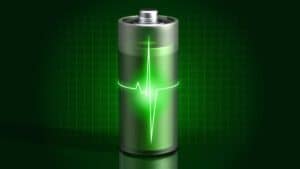
While batteries are the most common form of energy storage in everyday life, used in phones, tablets, watches, remotes and many other household items, they are not the only type of energy storage device. Each type is suited for different applications. Here are 3 different types of energy storage devices and the different ways they are used.
Batteries
Batteries are electrochemical devices, generating electricity through chemical reactions. Connected with an external circuit, electrons inside the battery flow from one electrode to the other, creating an electrical current that powers the load. Particular combinations of materials do not react in the same way, and each chemistry can store different amounts of energy and operate at different voltage ranges. Lithium-ion batteries are the most commonly used nowadays, favored because of their high capacities, stability, low self-discharge rate, and relatively low need for maintenance. Lithium-ion batteries can also be charged and discharged many times while maintaining its integrity and safety. Alkaline batteries are another common battery chemistry, used to power remotes, flashlights, toys and many other items. Lead-acid batteries are used in cars to start the motor.
In smaller applications, batteries are quite favorable; phones, tablets and other portable devices can last for a day before needing to be recharged. However, when it comes to larger applications such as electric vehicles or grid storage, their capacity still falls short. Batteries are the heaviest and most expensive part of an electric vehicle, and most still do not hold enough capacity to match up to internal-combustion engine vehicles. Further improvements in batteries will eventually even out the playing field, allowing for the same size of batteries to store more energy than before, increasing its competitiveness and viability for large-scale applications.
Redox flow batteries are another type of chemical cell, but they operate in a completely different way than typical cell batteries. Flow batteries are liquid based, consisting of two half-cells each connected to an electrolyte tank. The half-cells are filled with the cathode and anode solutions and energy is released or store through the continuous circulation of the electrolytes through the half-cells.
Redox flow batteries
Unlike lithium batteries, flow batteries are favorable for larger-scale, albeit, stationary, applications. Energy capacity is easily scalable by using bigger tanks and more concentrated electrolyte solutions. However, since they are typically quite large in size, they are not the best choice for portable applications. With some experts suggesting that they can last up to 30 years, they are being explored as a cost effective alternative for large-scale energy storage.
Supercapacitors
Supercapacitors, on the other hand, store energy statically rather than chemically. An electric field is created when ions present in the electrolyte migrate from one metal electrode plate to another.
Supercapacitors are very different from chemical-based energy storage devices. They do not have high energy density, holding only 1 to 30 Wh/kg. However, they have very high power densities, meaning that it can release a large amount of energy, as well as recharge, in a short period of time.
The nature of the supercapacitor makes it suitable for high-powered applications such as regenerative braking. In grid storage applications, the supercapacitor can act as a buffer to meet peak-load demand, quickly releasing energy into the grid when there is a sudden spike in demand, before the main energy storage can kick in.
Each type of energy storage device has their advantages and limitations. Some are looking at how to combine different types and capitalize on their advantages. Researches at the Queensland University of Technology are working on a hybrid of batteries and supercapacitors to create a device that can have the energy capacity of batteries with the power density of supercapacitors. These kinds of innovations will help push energy storage forward and create more efficient solutions for the future. From batteries, to flow batteries, to supercapacitors, Arbin Instruments has high quality equipment to test different types of solutions. Talk to an expert today to find what suits your research and development needs.

